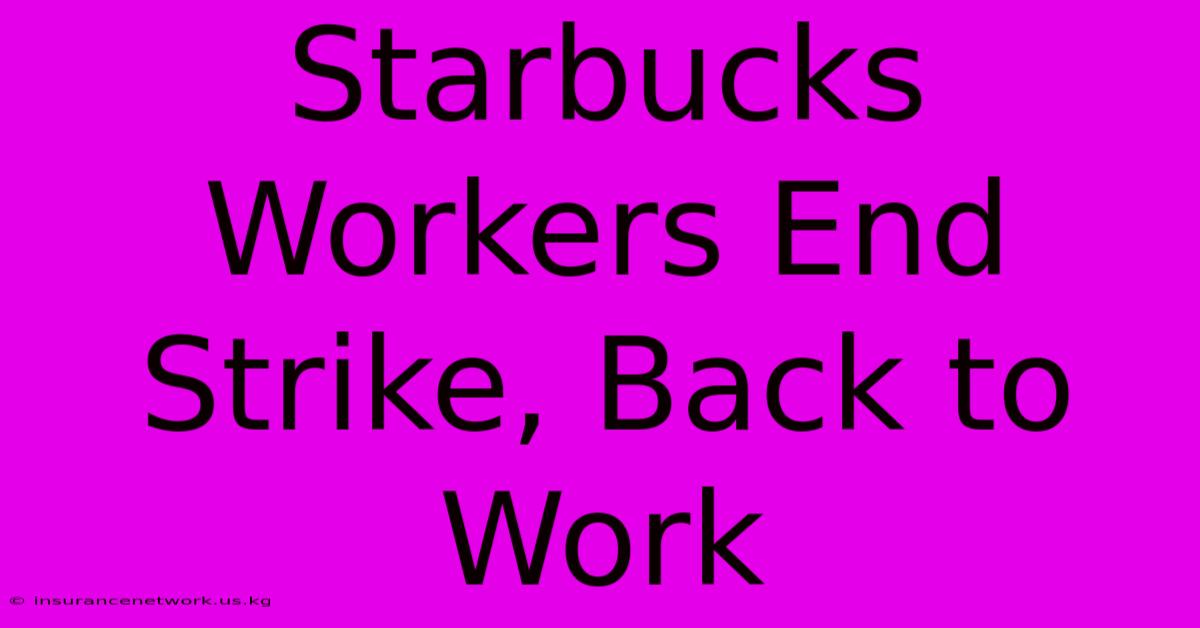Starbucks Workers End Strike, Back To Work

Discover more detailed and exciting information on our website. Click the link below to start your adventure: Visit Best Website insurancenetwork.us.kg. Don't miss out!
Table of Contents
Starbucks Workers End Strike, Back to Work: A Union Victory?
After weeks of striking, Starbucks workers across the country have returned to their baristas stations. This marks a significant turning point in the ongoing labor disputes between Starbucks and its unionized employees. But what does this mean for the future of unionization at Starbucks? Was this a victory for the workers, or a strategic retreat? Let's delve into the details.
The Strike: A Summary of Key Demands
The strike, which involved workers at numerous locations, wasn't a spontaneous event. It was the culmination of months of negotiations and disagreements over various critical issues:
- Fair Wages and Benefits: A core demand was a significant increase in wages to match the rising cost of living, along with improved healthcare benefits and retirement plans. Starbucks workers, many of whom rely on tips to supplement their income, argued their compensation wasn't enough to meet their needs.
- Safe Working Conditions: Concerns about understaffing, leading to unsafe working conditions and excessive workload, were also prominent. Workers reported feeling overworked and stressed, impacting their well-being and performance.
- Union Recognition and Respect: This was arguably the most contentious issue. Workers demanded full recognition of their union and an end to what they considered anti-union tactics by Starbucks management. Allegations of intimidation and unfair labor practices fueled the strike.
Why Did the Strike End?
The reasons behind the end of the strike are complex and multifaceted. While no official statement definitively outlines the reasons, several factors likely played a role:
- Negotiations and Compromises: Reports suggest that behind-the-scenes negotiations between Starbucks management and union representatives resulted in some concessions, though the specifics remain largely undisclosed. These compromises likely addressed some, but perhaps not all, of the workers' demands.
- Economic Pressures: Extended strikes can be financially draining for workers who rely on their wages. The decision to return to work may have been influenced by the economic realities faced by individual employees.
- Strategic Considerations: The union may have decided that a strategic retreat was necessary to regroup and plan for future actions. Returning to work doesn't necessarily mean the fight is over; it could be a tactical maneuver to assess the situation and prepare for further negotiations or actions.
The Aftermath: What's Next for Starbucks and its Unionized Workers?
The return to work doesn't signify the end of the labor dispute. Several crucial questions remain unanswered:
- Long-Term Contract Negotiations: The immediate return to work doesn't guarantee a favorable long-term contract. Negotiations are likely to continue, focusing on the unresolved issues.
- Continued Unionization Efforts: The strike, regardless of its outcome, has galvanized unionization efforts at other Starbucks locations. The struggle for better working conditions and union recognition is far from over.
- Public Perception and Brand Image: Starbucks' response to the strike has significantly impacted its public image. The company's handling of the situation will likely influence consumer perception and brand loyalty.
Analyzing the Success of the Strike: A Balanced Perspective
Whether the strike was a "success" is a matter of perspective. While some demands may have been met through negotiations, others may remain unresolved. The long-term impact of the strike on wages, benefits, and working conditions for Starbucks employees remains to be seen.
The strike highlighted the growing power of organized labor and the determination of Starbucks workers to fight for better working conditions. The outcome, while seemingly a return to work, is only one chapter in an ongoing battle for fair treatment and union recognition within the coffee giant. The coming months will be crucial in determining the true impact of the strike and the future of the labor movement within Starbucks.

Thank you for visiting our website wich cover about Starbucks Workers End Strike, Back To Work. We hope the information provided has been useful to you. Feel free to contact us if you have any questions or need further assistance. See you next time and dont miss to bookmark.
Featured Posts
-
Nfl On Netflix Christmas Day
Dec 26, 2024
-
38 Dead In Azerbaijan Airlines Kazakhstan Crash
Dec 26, 2024
-
Netflix Nfl Christmas Success
Dec 26, 2024
-
Hanukkah Lights Up Winter Park
Dec 26, 2024
-
Beyonces 2024 Super Bowl Halftime Show
Dec 26, 2024
